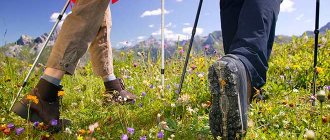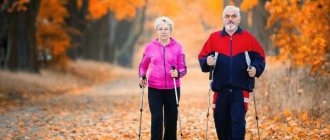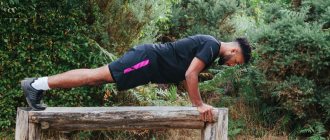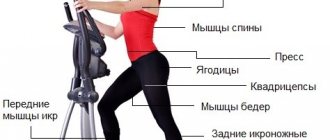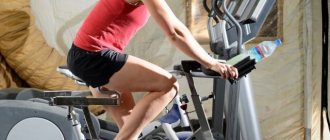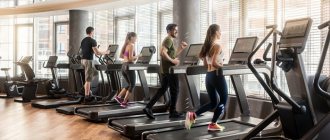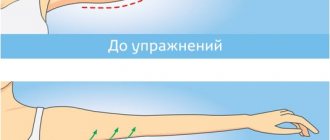Why is it useful?
The growing popularity of this sport can be explained by the fact that with Nordic walking with poles, the benefits and harms are incommensurable.
The undoubted advantages of Norwegian walking with poles are as follows:
- By using poles, the load on joints and knees is reduced, unlike running and race walking.
- Strengthens posture and the entire musculoskeletal system.
- Blood circulation improves, blood pressure and heartbeat are normalized.
- It helps to lose excess weight, in addition, for obese people, walking with poles is a way out, because with other sports activities the load on the joint apparatus will be destructive.
- An important aspect of its usefulness is the minimal effort available to everyone. You can study on your own or with a group at any time of the year, anywhere.
- When walking in this way, many muscles are involved in the process, which in ordinary life a person uses little or rarely. If you don’t do push-ups, don’t do pull-ups, don’t work out the area between the shoulder blades, then in the collar, interscapular area, blood stops supplying the muscles, and salts begin to be deposited, and during exercise, all deposits gradually “resolve.”
- Improves mood, helps get rid of depression. Vigorous arm swings help open the chest, allowing the person to “breathe” freely and easily. It was noticed long ago that a happy person walks with a flying gait, waving his arms, and waving his arms during exercise gives a feeling of freedom and confidence.
- During Nordic walking, as with swimming, 90% of all muscles work in the body.
- The heart rate during Nordic walking increases by 10-15%.
- Nordic walking is recommended after a stroke; it helps restore balance and coordination of movements. In ordinary life, right-handers and left-handers, as a rule, use only one hemisphere (left and right) - this manifests itself in an imperceptible imbalance, it becomes obvious during the first Nordic walking lessons, when the gait of beginners is characterized by impaired coordination, but with practice - that’s all is being restored.
Who benefits from walking with poles?
The popularity of Nordic walking began to grow rapidly after German scientists published studies confirming the high health benefits that athletes receive. If during a normal walk about 70% of the muscles are involved, then during Nordic walking, the activity of muscle tissue reaches 90%. This occurs due to active hand movements.
In addition, poles significantly reduce the load on the heels, knees, and hip joints. This allows Nordic walking to be used as rehabilitation after injuries, surgeries, serious illnesses, as well as for people with pathologies of the lower extremities, including gout, heel spurs, etc.
During Finnish walking, significantly more calories are burned than during a regular walk, so the exercise is recommended for those who want to lose weight. During movement, the number of heartbeats increases, which provides high-quality cardio training.
Scientists confirm that Nordic walking develops a sense of balance, coordination of movements, and is considered an excellent solution for improving posture.
Thanks to the activity of the upper body, the tidal volume of the lungs increases by a third compared to a usual walk. The video will tell you more about the benefits of Nordic walking. Video about the benefits of Nordic walking
Indications
Almost everyone can do Nordic walking, but it will be an excellent way to improve the body’s health for the following diseases:
- For diseases of the neck, lower back, spine (osteochondrosis, etc.).
- For posture problems (scoliosis). In Finland, to combat teenage stoop, Nordic walking classes are included in the school curriculum in high school.
- For constant pain in the back and neck.
- If you have diseases of the lungs, upper respiratory tract (bronchial asthma).
- For certain cardiovascular disorders (coronary disease).
- If you have a difficult psychological health condition (depression), sleep is disturbed.
- For tremors (shaking) of the hands (Parkinson's disease).
- If you suffer from extra pounds.
What special equipment is required?
To practice Nordic walking, you need comfortable clothes and sneakers, as well as sticks. Clothes should be comfortable and not restrict your movements; it is best to wear a tracksuit.
Sneakers should have fairly thick soles, comfortable lacing, and not heavy. It is best to choose running shoes for rough terrain.
Contraindications
Walking with poles has the following motto: “at any age and with any body type, at any time of the year and in any place.” It follows from this that everyone has indications for Nordic walking, and there are no contraindications, but this is not entirely true.
Serious training is not recommended for children under 11 years of age.
In addition, Nordic walking is contraindicated when any physical activity is prohibited:
- After surgery, surgery during the recovery period.
- For inflammatory and infectious diseases.
- When blood clots form (thrombophlebitis).
- For severe diabetes mellitus that is not controlled by insulin.
- If a person is in an acute period after a recent stroke or heart attack.
- For severe heart rhythm disturbances.
- For sudden bleeding.
- For severe hypertension, which is characterized by uncontrolled attacks of pressure above 180/110 and resistance to medications.
- If myopia progresses rapidly, causing blindness, or glaucoma develops.
- If lung capacity decreases, which leads to severe failure.
As a rule, such people simply will not be able to come to Nordic walking classes, so if you are not prohibited from walking, then you are not prohibited from practicing this method.
In addition, it should be taken into account that in some cases Nordic walking classes in groups are prohibited, but individually with an instructor you can:
- During the recovery period after surgery on the leg joints.
- If during 3 months of classes, a person regularly fell.
- If a person has severely impaired coordination of movements (severe Parkinson's and other reasons).
- If arthrosis is observed in the hands at such a stage that it is impossible to hold the canes.
The most common contraindication for any sports activities is an acute infectious disease (cold, etc.).
Important! This sport is not prohibited for pregnant women; some practice it up to 40 weeks.
Features and differences
The term “Nordic walking” is especially popular in the Russian Federation, since the first information about physical activity came from the north, from Scandinavia. The name in English, Nordic Walking, means the same thing; the Finns immediately talk about “walking with sticks”. The new product first appeared in the 1990s, found a huge number of fans in Western Europe, and slowly reached the vast eastern region.
Although in Russia and neighboring countries it is still a rare phenomenon, quite often people walking cheerfully in the summer with “ski poles” are greeted with surprised glances. More modern, advanced observers immediately understand that poles have nothing to do with skiing; before them is a demonstration of a new type of sports movement - Nordic walking.
There are differences between ordinary race walking, known since time immemorial, and Scandinavian (Nordic)
An important device - walking poles - also changed the intensity of physical activity and direction. Normal movement involves the lower body and back, which are subject to quite heavy loads without support.
The arms and shoulder girdle remain unloaded during race walking.
Select poles brief instructions
The success of your Nordic walking training greatly depends on the choice of poles; the main criteria for their correct selection are:
- Length or height - in this case, the market offers telescopic and monolithic poles. Telescopic ones have many connections, thanks to which you can select the length and adjust them; monolithic ones have a solid barrel. You should pay attention to telescopic poles only if you travel often and want to always have them with you. For constant, regular exercises, it is best to take monolithic sticks, as they are more reliable and stable than with a folding mechanism.
- What should be the height of the cane? When developing poles for Nordic walking, it was experimentally determined that their height for each person is calculated according to the formula: human height * 0.68, for athletic people the length can be taken a little longer than height * 0.7, for untrained overweight people, it is better to take There are fewer of them – height*0.66. If it is not possible to calculate the length, then you need to take the sticks in your hands so that a right angle is formed in the bend of the elbow, and they should not reach the floor by 2-3 cm.
- The bottom of the stick (tip) should be sharp and metal, but a special rubber tip is attached to it. If you walk on asphalt, concrete or other hard surfaces, then you will need to put it on, otherwise take it off.
- At the top of the handle there is a special glove (lanyard), which is adjusted to the size of the hand, they are designed for the left (Left) and right (Right) hands, it is fixed on the wrist, you must learn how to clamp it yourself so that it does not squeeze your hand and when the handle did not fall far down.
- The barrel of the stick had to be made of light, strong, elastic materials (carbon).
- As for whether it is possible to practice with ski poles, I must say that they differ significantly in length and tip, so you will be awkward and uncomfortable with them.
Equipment
Special poles are used that are much shorter than ski poles. The handles of the poles have special straps that are attached to the hands and resemble fingerless gloves. This allows you to operate inventory without making significant efforts.
For Nordic walking you need to purchase special poles
The second stage is the selection of shoes. It is best to use sports sneakers with shock-absorbing soles or insoles to reduce stress on the joints of the lower extremities and spine.
How to choose Nordic walking poles
There are 2 types of poles: fixed and telescopic, which can be adjusted by adding retractable elements. They have the lowest possible weight. For this, aluminum, carbon fiber or high-quality composite materials are used.
The basic selection rules are as follows:
- The handle should be comfortable and fit well in the hand.
- The strap should not dangle loosely or put unnecessary pressure on your hand.
- Choosing the right tip. For hard surfaces, a rubber one is used; for walking on ice, snow and the tropics, a spike made of hard materials (metal, plastic) is used.
- Adequate length.
You need to approach the choice of equipment for classes responsibly
How to adjust poles according to height
Choosing the right length of poles is the most important step. The size of the equipment depends solely on the height of the person, and not on the degree of desired load or age. Neglecting these circumstances will lead to significant stress on the pelvic apparatus, knee joints and spine. For ease of perception, a table is presented.
| Human height, cm | Height of poles, m |
| 195 and above | 1,35 |
| 187–194 | 1,30 |
| 181–186 | 1,25 |
| 174–180 | 1,20 |
| 168–173 | 1,15 |
| 162–167 | 1,10 |
| 153–161 | 1,05 |
| 145–152 | 1,00 |
How to do Norwegian walking correctly
In order to know how to walk with poles correctly, you need to either take a couple of lessons from an instructor or read special information yourself or watch video tutorials.
In order to understand what its meaning is, you need to learn several stages - maintain coordination of movements, use sticks correctly, choose the appropriate walking rhythm.
The initial stage of Nordic walking will be normal walking with a “counterstep” technique, in which the left leg meets the right hand as you step, then the left hand meets the right leg. At this time, the sticks need to be taken by the middle and carried parallel to the ground, during a step the hands rise to the level of a handshake, they are straight, not bent, the amplitude of movements back and forth is the same.
You need to start at a slow pace, then gradually speed up, swinging your arms wider and wider.
The foot that takes a step should roll from heel to toes. Don't focus on the canes, move your arms freely with relaxed shoulders.
The main goal of this exercise is to achieve a natural walking pace with coordinated movements of the arms and legs.
The next exercise will be dragging sticks behind you: you need to lower the sticks with their tips to the ground and pull them behind you with relaxed hands. The lanyards must first be secured to the hands. You need to walk, forgetting about the sticks, placing them close to the body, using the “counterstep” technique, while the tips drag along the ground.
After 100 meters, check which leg you are moving forward with your left arm, if it is not your right leg, then leave the poles and try to achieve the correct “counterstep” technique.
The next step is to position the stick; you need to extend your hand with the stick to the level of a handshake, while the tip will rest against the back and you should feel that it is ready to push off.
Next, we learn to push off from the sticks, take a step with our right foot and bring our left hand with the stick forward, at the same time as the right heel touches the ground, the stick should be pushed into the surface. The stick is at the back. When taking the first step, you need to stop and check your posture, lean on a stick, change your center of gravity from your right to your left leg.
Then we take the next step and pay attention to the force of pressing the stick; the longer and more we press on the stick, the better for the muscles. At this point, the elbow should be extended in front of the body, as if you are preparing to shake hands. The movement should be not only in the elbow up and down, but also in the shoulder joint - forward, backward.
By observing all these movements, you begin to take the first steps in the Nordic walking technique, and you go further and further.
How often are classes held?
The work program should consist of 3-4 lessons per week, the duration of Nordic walking training is approximately 45 minutes -1 hour. In an hour, a good result would be a mileage of 6 km.
First rule
With the right approach to a Nordic walking lesson, it should include 3 stages:
- Warm up.
- Main part (Nordic walking).
- Closings or afterwords.
The main goal of any warm-up is:
- Warming up all muscle groups, starting with small ones, moving on to large ones, going beyond the usual movements.
- Preparing the heart through a gradual increase in heart rate, so that when moving to the next stage there is no sudden jump in heart rate.
Warm-up duration is approximately 5-15 minutes.
What activities does warm-up include?
- Regular walking, in which the poles need to be carried, holding them in the middle, parallel to the ground.
- Exercises with swing and rotational elements to develop the shoulder, knee and ankle joints.
- Stretching the muscles of the back, legs, shoulders.
Examples of warm-up exercises:
- Feet are shoulder-width apart, sticks in hands. You need to bend your knees a little to lean on the poles, and then roll from heel to toe, from toe to heel.
- Leaning on the sticks, swing your legs alternately.
- The stick must be placed on the back of the neck, grasped like a “barbell” with both hands and, without rotating the pelvis, make several tilts of the body to the right and left.
How should your hands work?
When Nordic walking, your arms should move in the same way as with a confident, free-moving gait.
The hands should always be at a small distance from the body, moving according to the “counterstep” principle described above - the left heel simultaneously lowers to the ground with the right tip.
It is important to understand that Nordic walking does not require unnatural arm movements; they should not be larger than the swings that a person makes when walking quickly, confidently, without poles.
The highest point of amplitude when bringing the hand forward is equal to the movement of the hand during a handshake. When moving back, the elbow joint straightens and the hand opens.
If the hand does not rise to a sufficient level and the push-off with the stick is weak, then the step is small and the pelvis moves little, on the contrary, the stronger the swings of the arms and push-off, the longer the step and the more the pelvis is involved. When the hand goes down, relaxation occurs in the hand and the cane is held with a lanyard
How to hold sticks
The basics for the correct use of Nordic walking poles are as follows:
- The handle of the stick should have the letters R or L on it, which means right and left stick.
- The hand must be threaded through the lanyard so that the thumb and index finger are located opposite the hole in the lanyard.
- Then secure the lanyard comfortably on your hand.
- Your thumb should rest on top of the lanyard fastener to make sure it doesn't fly open.
- In order to find out whether you have secured the poles correctly, stretch your hand forward so that your palm is open; if you feel good and your hand and the pole are in harmony, you feel that it is an “extension” of your hand, then you have done everything correctly. If there is a lot of free space between your hand and the lanyard, adjust it.
What should be your posture?
Those who regularly practice Nordic walking should know that posture is important to maintain good physical shape while walking.
Each person has his own individual characteristics, the ideality of posture is a rather subjective factor, but there are still certain recommendations on what the posture position should be during Nordic walking:
- The shoulders should not be tense, they should be in a relaxed state.
- The back remains in a straight position, taking into account the fact that the torso is slightly tilted forward (5-7 degrees).
- The tummy should not be relaxed, but taut, but at the same time you should breathe freely.
- Don't lower your head, look into the distance at the horizon or at least 10-15 meters ahead of you.
- There should be free rhythmic breathing that encourages you.
- Remember to roll your foot as it touches the ground all the way to your toes.
How do lessons end?
Nordic walking training ends with a relaxation phase. This is necessary in order to restore normal heart rhythm so that the body can return to normal, everyday functioning and prevent negative consequences in the form of muscle spasm by stretching them. You can add exercises to develop muscles and strengthen endurance.
Depending on how much time was spent on the main part of the workout and what exercises you will do, the duration of this phase is 5-30 minutes.
Elements of the relaxation phase:
- Gradually reduce the pace of walking; during the last 5 minutes, carry the poles in your hands, holding them in the middle.
- If you can, do a couple of strength exercises (squats, push-ups).
- Standing still, stretch your muscles.
- Relaxation exercises along with breathing restoration.
The elements in this phase are arranged in the reverse order relative to the initial phase of Nordic walking training.
If you are finishing the main part, you cannot stop abruptly. If you want, you can include exercises for flexibility, strength, and endurance.
Pay attention to the cervical spine, you need to perform a couple of stretching and flexibility exercises in this area, this improves blood flow in this area and improves the condition of patients with hypertension. But at the same time, you should not make sudden movements, strong turns of the head; the best thing is slow turns of the head to the right and left, tilts to the shoulders.
When performing breathing exercises, exhalation should be longer than inhalation - this contributes to greater relaxation of the body.
Walking rules
Now we will give you Nordic walking lessons. More precisely, we’ll tell you how to move, step by step:
- Stand straight, bend your knees slightly. Move your left hand back and hold the stick in it at an angle. Bend your right arm at the elbow. Then pull it forward strongly.
- Now take a step with your left foot, while moving your right hand back. Try to smoothly transfer your weight onto the stick in front. Keep your elbows straight! The right hand goes back, and the stick in it almost hangs on the straps. The palm is slightly relaxed. The technique is simple: right hand - left leg, left hand - right leg.
- When you take a step, step onto your heel first. Then roll smoothly onto your toes.
- Move slowly to learn proper technique. In fact, it will be just walking. But in the process you are dragging sticks behind you. Secure the correct positions of your legs and arms.
- Now about breathing - inhale through your nose every 2 steps. Exhale through your mouth on step 4.
- When you master this type of walking well, you will begin to push off. First from one stick, then from two at once.
For a better understanding, study the video and watch professional master classes.
I assure you, training will not take much time. I recommend following the link to the article “Nordic walking for beginners.”
Common mistakes
Errors during Nordic walking are not fatal, but they reduce its effectiveness, the most common of which are:
- Inactivity or little use of the upper shoulder girdle.
- Insufficient “throwing” of the stick back.
- The stick is thrown far forward, further than the legs.
- There is no need to artificially move the stick, it should drag along with your hand.
- The stick is clamped in the fist, all movement should be through the glove (lanyard).
- Insufficient emphasis on the sticks with your hands.
Benefits for weight loss
If you are overweight, running is prohibited due to the heavy load on the joints. In addition, running activities have many restrictions due to their safety. When running, it is possible to injure the spine, stretch muscles, and cause overstrain of the cardiovascular system. Therefore, the question of whether running or walking is better for losing weight should be decided depending on the doctor’s recommendations, your well-being and personal preferences.
It is important to note that Nordic walking helps only 30% of losing weight; the remaining 70% of weight loss depends on your diet. Regardless of how many kilocalories are burned during training, improper nutrition will quickly “replace” them.
The walking technique for losing weight is no different from the correct technique of regular Nordic walking. Interestingly, 30% more calories are burned in 1 hour during Nordic walking than during a regular walk.
What is more effective in helping you lose weight?
Finnish or regular walking
Depending on the speed of movement, Nordic walking can increase the number of calories burned by almost 50%. This happens because during training you have sticks in your hands, which involve not only the lower, but also the upper body in the work. Therefore, such exercises are much more effective for rapid weight loss.
Nordic walking or running
Jogging used to be very common, but with the advent of Finnish walking its popularity has decreased. This is not surprising, because people who are fond of Nordic walking get rid of extra pounds faster. Of course, subject to regular training.
In addition, doctors are against running for those who want to lose weight. After all, constant impacts of limbs on a hard surface are not at all beneficial for joints, knees and the musculoskeletal system.
Nordic walking is also recommended for obese people. Running is contraindicated for such people for the reasons stated above. Therefore, walking will help them lose kilos.
Finnish walking is the safest and easiest physical activity for overweight people.
Is Nordic walking possible for coxarthrosis?
Is it possible to do Nordic walking with arthrosis of the knee joint and other manifestations of arthrosis - this is a question that worries many. As a result of research in 2020, it was proven that the effect of Nordic walking for arthrosis is positive, and not negative, as previously thought.
About 100 people over 60 years of age with various forms of arthrosis of the hip and knee joints took part in the study and more than 90% of them noted:
- There was no significant pain during Nordic walking.
- There was a significant increase in the distance they were now able to travel.
The duration of the study was 3 months, during which these improvements progressed. But for those who stopped and returned to normal walking, all symptoms returned.
The average duration of the disease in this group was 11 years, during which they were no longer helped by medications, physiotherapy and other types of medical care. None of the participants dared to engage in Nordic walking, fearing deterioration, because medicine has virtually no research on the benefits of this method. There is currently talk that Nordic walking could become a definite treatment method for people with arthrosis.
Additional Research
The benefits of Nordic walking with poles have been confirmed by numerous studies. One of them (Hendrickson, 1993) involved 16 men and women who did not suffer from any diseases. During the experiment, they walked on a treadmill with and without poles at a speed close to easy running of 6.5-7.5 km/h.
It was shown that using poles while walking at this speed resulted in increased oxygen consumption, increased heart rate and increased calorie expenditure by approximately 20% compared to the same group of people walking at the same speed but without poles.
Subsequently, additional studies were conducted that gave similar results:
- Oxygen consumption increased by 23%
- Heart rate increased by 14-16%
- Energy consumption increased by 22-55%
The research results allowed us to draw the following conclusions about the benefits of Nordic walking with poles:
1. This type of physical activity is an excellent cardiovascular exercise for the prevention of cardiovascular diseases.
2. Saturating the body with oxygen improves the nutrition of all cells, stimulates the functioning of the immune system and other systems.
3. With a duration of more than 30 minutes and an intensity of 7 km/h, Nordic walking helps you lose weight.
Thus, as a result of additional research, it has been proven that the benefits of Nordic walking with poles are obvious not only for the disabled and the elderly, but also for people without health problems.
How to walk correctly for maximum effect
To calculate the effectiveness of exercises, an indicator of the individual threshold of aerobic-anaerobic support (IATN) was introduced, but its measurement requires a complex study, so this procedure is expensive for ordinary people involved in Nordic walking. The solution is to simply measure the pulse rate, unless the person has any pathologies that prevent accurate heart rate measurement.
To measure the effectiveness of your Nordic walking session, you must:
- Measure your pulse in the morning while still in bed - a state of maximum rest.
- Measure at the heaviest load - the highest frequency; if this is not possible, it is calculated using the formula: 220 - human age (60, 70 years).
- A workout is considered effective and useful if the heart rate is from 55 to 75% of the heart rate at maximum load.
There are 3 levels of classes:
- Wellness – intended for those who have various diseases. The recommended heart rate is 55–65% of the maximum, the frequency of exercise is from 2 to 7 times a week.
- “Fitness” - this workout is for an ordinary person, the load on the pulse is 65–75% of the maximum, the frequency of exercise is about 2–6 times a week. High fitness level for people in good physical shape is recommended 1-2 times a week with a heart rate of 75-85% of maximum values.
- Sports level - for professional athletes in preparation for competitions, it is recommended to exercise 2 times a week with a heart rate load of more than 85% of maximum values.
Choosing the right poles
Choosing the right size sticks is very important. https://www.youtube.com/embed/cJYj1V4hHfU
Too small or, conversely, too long specimens lead to poor posture, frequent stumbling, and muscle imbalance.
Too small or, conversely, too long specimens lead to poor posture, frequent stumbling, and muscle imbalance.
Models are made from three materials (aluminum - the cheapest, fiberglass - medium, carbon - the most expensive), all must contain carbon. The higher the proportion of carbon, the stronger the model and the less vibration.
It is worth distinguishing between models with a fixed and telescopic length. The length of the fixed ones cannot be changed, they are sold with a length difference of 5 centimeters, ideal for those who are overweight. Telescopic options are very variable in length, suitable for people of normal weight, growing teenagers, and for use in steep terrain. Telescopic ones are more flexible in use, but noisier and less vibration-resistant, so fixed ones are much stronger than their rattling “brothers”.
The photo shows Swedish walking poles:
In order to find out the optimal size, you must adhere to three criteria: relation to body length, angle of the forearm relative to the other part of the arm, testing.
| Criteria | Details |
| Relation to body length | In order to find out the optimal length, there is a special coefficient equal to 0.66. It must be multiplied by the person’s height in centimeters, and the resulting result rounded to a number that is divisible by five. For example: 174 cm x 0.66 = 114.84. We round the number, getting 115 centimeters - the most optimal length of a stick for a person 174 centimeters tall. |
| Angle of the forearm relative to the other part of the arm | For the second step, fixed models in gauge length or adjustable telescopic sticks are required. This angle is measured with the arm relaxed, the shoulder parallel to the body, and the pole positioned as it would be if you were starting to walk. The optimal angle is from 90 to 100 degrees. |
| Testing | After finding the optimal length, you need to check in practice how good the choice is. Ask your friends or trainer to check your technique for performing the exercise. There must be good posture, the correct movement, during it you need to move optimally and naturally. Only when you walk correctly, as confirmed by your trainer (or friend), and you feel comfortable exercising, can the models be considered suitable. |
Entry-level models cost approximately 15 euros, while the best products can have a price tag of 150 euros. Models with an ideal combination of price and quality cost an average of 50 euros.
Tips should be made of hardened steel, and also have removable rubber caps that reduce the volume of the sound of the tip touching, for example, asphalt. They should also be easily replaceable, because otherwise they will wear out, lose grip, and the quality of your walks will decrease.
The handle also matters. The best example of a shape is wedge-shaped, where the diameter of the handle near the little finger is smaller than near the thumb.
The material should repel moisture and prevent your hand from slipping. Here natural cork is recognized as the best material.

